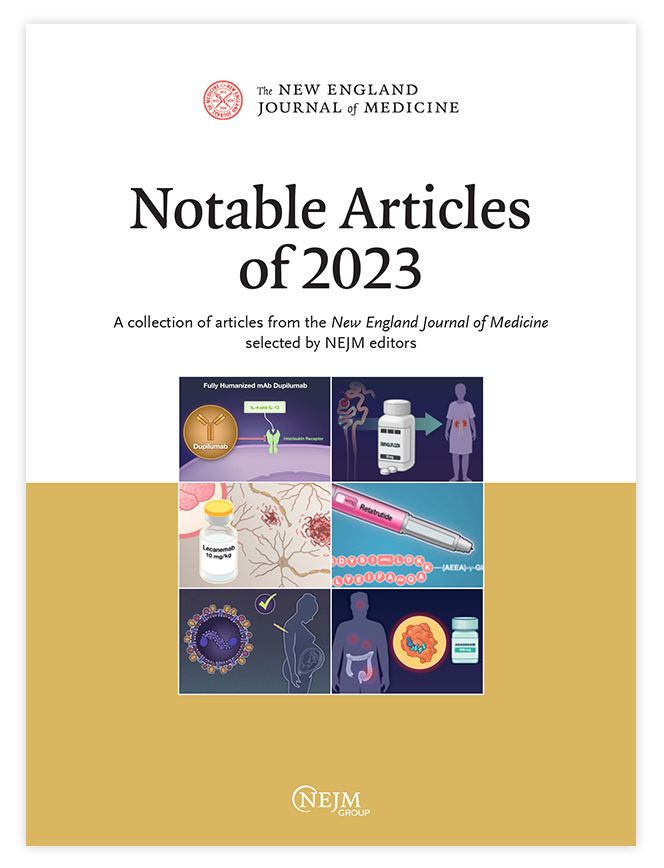脑卒中取栓前静脉注射替奈普酶。
IF 96.2
1区 医学
Q1 MEDICINE, GENERAL & INTERNAL
引用次数: 0
摘要
背景:大血管闭塞急性缺血性卒中患者血管内取栓前静脉滴注替奈普酶治疗的安全性和有效性尚不确定。方法:在中国进行的这项开放标签试验中,我们随机分配了发病后4.5小时内出现大血管闭塞的急性缺血性卒中患者,这些患者符合溶栓条件,接受静脉注射替奈普酶并血管内取栓或单独血管内取栓。主要结果是功能独立性(在修改的Rankin量表上得分为0到2分;范围从0到6,分数越高表明残疾越严重)。次要结局包括取栓前后的再灌注成功。安全性指标包括48小时内出现症状性颅内出血,90天内死亡。结果278例患者随机分为tententemase联合取栓组和272例单独取栓组。tententemase - thromectomy组的147例患者(52.9%)和单独取栓组的120例患者(44.1%)在90天功能独立(未调整的风险比,1.20;95%置信区间为1.01 ~ 1.43;p = 0.04)。取栓组和单独取栓组分别有6.1%和1.1%的患者在取栓前再灌注成功,取栓后再灌注成功的比例分别为91.4%和94.1%。溶栓组患者48小时内出现症状性颅内出血的发生率为8.5%,单独溶栓组为6.7%;90天死亡率分别为22.3%和19.9%。结论在发病后4.5小时内出现大血管闭塞性急性缺血性卒中的患者中,静脉注射替奈普酶联合血管内取栓术在90天功能独立的患者比例高于单独血管内取栓术。(重庆市科卫联合医学研究项目等资助;BRIDGE-TNK ClinicalTrials.gov号码:NCT04733742)。本文章由计算机程序翻译,如有差异,请以英文原文为准。
Intravenous Tenecteplase before Thrombectomy in Stroke.
BACKGROUND
The safety and efficacy of treatment with intravenous tenecteplase before endovascular thrombectomy in patients with acute ischemic stroke due to large-vessel occlusion remain uncertain.
METHODS
In this open-label trial conducted in China, we randomly assigned patients with acute ischemic stroke due to large-vessel occlusion who had presented within 4.5 hours after onset and were eligible for thrombolysis to receive either intravenous tenecteplase followed by endovascular thrombectomy or endovascular thrombectomy alone. The primary outcome was functional independence (a score of 0 to 2 on the modified Rankin scale; range, 0 to 6, with higher scores indicating more severe disability) at 90 days. Secondary outcomes included successful reperfusion before and after thrombectomy. Safety outcomes included symptomatic intracranial hemorrhage within 48 hours and death within 90 days.
RESULTS
A total of 278 patients were randomly assigned to the tenecteplase-thrombectomy group and 272 to the thrombectomy-alone group. Functional independence at 90 days was observed in 147 patients (52.9%) in the tenecteplase-thrombectomy group and in 120 patients (44.1%) in the thrombectomy-alone group (unadjusted risk ratio, 1.20; 95% confidence interval, 1.01 to 1.43; P = 0.04). A total of 6.1% of the patients in the tenecteplase-thrombectomy group and 1.1% of those in the thrombectomy-alone group had successful reperfusion before thrombectomy, and 91.4% and 94.1%, respectively, had successful reperfusion after thrombectomy. Symptomatic intracranial hemorrhage within 48 hours occurred in 8.5% of the patients in the tenecteplase-thrombectomy group and in 6.7% of those in the thrombectomy-alone group; mortality at 90 days was 22.3% and 19.9%, respectively.
CONCLUSIONS
Among patients with acute ischemic stroke due to large-vessel occlusion who had presented within 4.5 hours after onset, the percentage of patients with functional independence at 90 days was higher with intravenous tenecteplase plus endovascular thrombectomy than with endovascular thrombectomy alone. (Funded by the Chongqing Science and Health Joint Medical Research Project and others; BRIDGE-TNK ClinicalTrials.gov number, NCT04733742.).
求助全文
通过发布文献求助,成功后即可免费获取论文全文。
去求助
来源期刊

New England Journal of Medicine
医学-医学:内科
CiteScore
145.40
自引率
0.60%
发文量
1839
审稿时长
1 months
期刊介绍:
The New England Journal of Medicine (NEJM) stands as the foremost medical journal and website worldwide. With an impressive history spanning over two centuries, NEJM boasts a consistent publication of superb, peer-reviewed research and engaging clinical content. Our primary objective revolves around delivering high-caliber information and findings at the juncture of biomedical science and clinical practice. We strive to present this knowledge in formats that are not only comprehensible but also hold practical value, effectively influencing healthcare practices and ultimately enhancing patient outcomes.
 求助内容:
求助内容: 应助结果提醒方式:
应助结果提醒方式:


